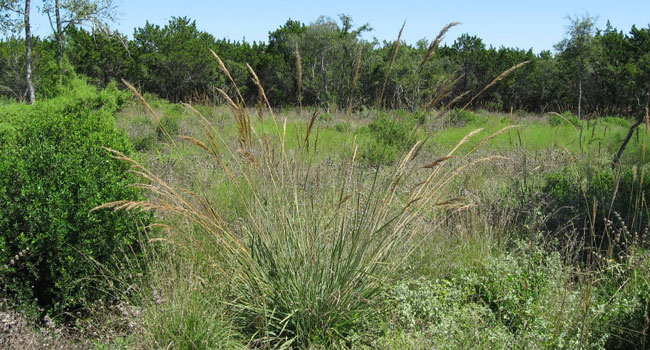Experts say grassland ecosystem's revival at Phil Hardberger Park would benefit the environment.
For decades, residents on the North Side have known the property that is now Phil Hardberger Park as an oasis of thick woods where deer hid and the branches muffled the roar of traffic.
Now with a $1 million grant from the Texas Parks and Wildlife Department planners are preparing for crews with chainsaws and heavy equipment to clear 2.5 acres of the 300-acre park to make way for grassland this fall.
Residents who have watched developers cut thousands of trees to replace them with parking lots and subdivisions are not sold on the idea, nor do they completely trust the conceptual renderings the park planners show them.
"Urban residents are much more keen on trees than they are on grasses," said Rufus Stephens, an urban biologist for TPWD. "You can't stand under a grass."
Less than 1 percent of the original 20 million acres of tall grass prairie that covered Texas remains. It is the most endangered ecosystem in North America. Undisturbed, a single square meter can support more than 100 species of grasses and scores of flowering plants. It was the base of a food chain nourishing everything from horned toads to bison.
Biologists working on the development of Phil Hardberger Park believe that before the Alamo was built, the site was home to an oak savanna landscape. Then, 6-foot grasses shaded out the Texas persimmon and Ashe juniper, also known as mountain cedar. After cattle ate down the grass and the fires that swept the region were stopped, the woody vegetation spread.
"These are native species," said project manager Tom Lee of the trees. "Just very aggressive. This is not healthy."
The trees have resulted in a drop in the number of hawk and owl species, songbirds, foxes and rabbits and the disappearance of the huge community of rodents, snakes and lizards that thrived in burrows dug into soil. Grassland is also better at feeding rainwater into the aquifer and pulling carbon gases from the air.
Because of these traits, the National Park Service, the U.S. Forest service and private endowments and agencies like the Nature Conservancy support grants and projects for grassland restoration.
Phil Hardberger Park is no exception.
The TPWD grant application estimated the cost of the 2.5-acre "grassland room" at $175,600.
"Restoration is a deliberate act," Lee said "If we have agreed that restoring this habitat is worth it, then we have to take action."
The planners assure they will go beyond San Antonio's strictest tree protection ordinances and will be undertaking a "very selective and deliberate process" in choosing which trees to cut.
Richard Alles, co-founder of the Citizens Tree Coalition, "We don't know what is contained in that area," he said.
Resident Claudette Mullen is concerned that the master plan calls for eventually creating dozens more acres of grassland.
"Just don't kill the native trees," she said "I'm not against grass."
What frustrates Mullen the most is the lack of answers from parks officials about what they plan to remove.
"We've been watching a fuzzy focus movie for a long time," she said.
Parks board member Charles Bartlett, vice chairman of the city's Parks and Recreation Board and a botanist, horticulturist and landscape designer questions the value of grassland. As suburban neighborhoods are built, the intentional loss of smaller trees and shrubs doesn't make sense, he said.
"This is a controversy that's been brewing since the very first original master plan public meetings," he said "The area is right now heavily populated by a number of mixed hardwoods - oaks, mesquites, Texas persimmon and condalia bushes that are not only historic but beautiful in their own right."
The San Antonio Conservation Society heard a presentation last week for the first time on the grassland-versus-trees issue and decided not to take action or pick a side.
"It's interesting," said president Marcie Ince. "We're proponents for trees and parks and this pristine location in the middle of San Antonio, and we're very interested in the historic aspects of the park. But we just can't micromanage that much."
One of the first elements to be completed at Phil Hardberger Park will be a 2.5-acre 'grassland room' to show visitors what the landscape looked like before European settlement. Work is expected to begin late this fall after soil and tree surveys are completed.
How to make a grassland room:
Texas persimmon and Ashe juniper have come to dominate the landscape of Phil Hardberger Park, replacing the native grassland after decades of heavy grazing and fire suppression.
After a tree survey and soil testing, crews will come in with chainsaws and heavy equipment to remove pre-selected trees and trim others to allow sunlight to reach the ground.
Depending on how the grasses come back on their own and the success of plantings, the 'grassland room' of Phil Hardberger Park will start to resemble the Blackland Prairie that once covered the area. If management is successful, the 2.5-acre lot could match the biodiversity of a true tallgrass prairie in less than 100 years.

